Cheap and Easy DIY Chicken Coop
- February 20, 2024
- 0 comment
This article introduces a straightforward and budget-friendly method for anyone interested in constructing a large chicken coop without spending a lot of money. Highlighting the expensive nature of buying pre-made chicken coops, with prices typically falling between $1,500 and $2,000, the writer proposes a smart alternative approach that drastically cuts costs while still providing enough room for chickens.
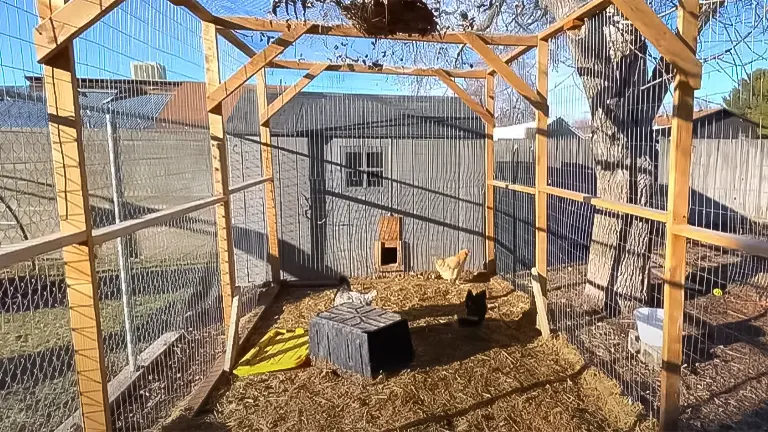
By focusing on the high costs associated with ready-made chicken coops, the article suggests a more economical and space-efficient solution. This approach is especially beneficial for individuals or families eager to set up a chicken coop without stretching their finances.
Table of Content List:
- Source Wooden Pallets
- Salvage Discarded Wood
- Planning and Design
- Use Plywood And Other Inexpensive Materials
- Reuse A Kitchen Cabinet or Boxy Wooden Structure
- Milk Crates Make Great, Easy Nesting Boxes
- Use Leftover Paint
- Use a Chicken Tractor Instead of a Traditional Coop
- Minimize Expenses Without Sacrificing Quality
Interior Design and Modifications
Inside the shed, the transformation is both simple and effective, turning it into a “chicken paradise.” The modifications are straightforward and doable, even for those with limited building skills. Key interior features include a roosting ladder made from basic lumber, heat lamps, and easily sourced nesting boxes set on cinder blocks.
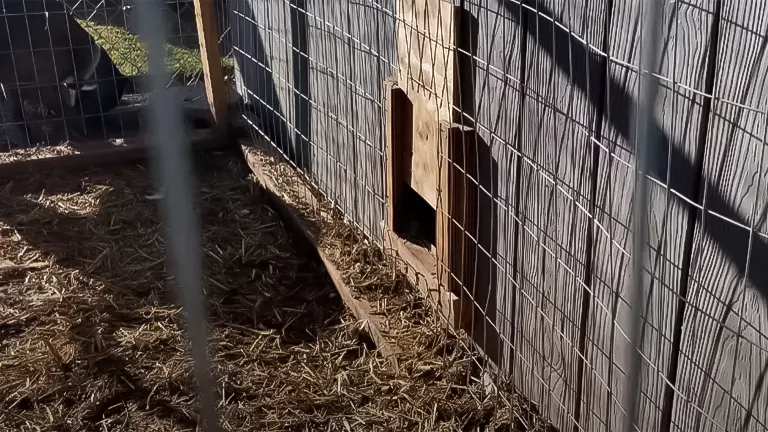
The author also highlights an innovative feeder made from a garbage can, capable of holding significant quantities of feed, and a basic but effective watering system, soon to be upgraded.
A unique aspect of the coop’s design is the cost-efficiency of the interior setup, with the author spending less than $100 on the modifications. This starkly contrasts with the high costs of ready-made coops, illustrating the substantial savings achieved through this DIY approach.
9 Affordable Strategies For Constructing A Chicken Coop
Raising chickens is rewarding but starting out can be costly, especially when it comes to building a coop, which is often the most expensive initial cost. Despite the high prices of pre-made coops, which can surpass $1,000, and concerns about the skills or costs involved in DIY projects, there are several ways to construct a chicken coop affordably. This includes reusing materials and designing for longevity, making the task both simpler and cheaper than expected:
1. Source Wooden Pallets
Sourcing wooden pallets for a DIY chicken coop project is an economical and eco-friendly strategy. These pallets are often available for free or at a nominal cost from local businesses, warehouses, or recycling centers, offering a sturdy base material for construction. Wooden pallets can be repurposed into various components of a chicken coop, including the frame, walls, and flooring.
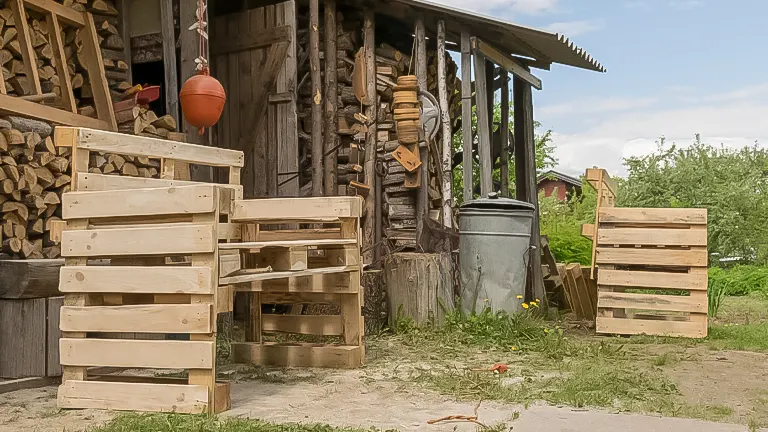
This method not only saves money but also promotes sustainability by reusing materials that might otherwise end up in a landfill. However, it’s important to select pallets that are safe and free from harmful chemicals or treatments. With some basic carpentry skills and creativity, wooden pallets can be transformed into a functional and durable chicken coop, proving that building a safe home for chickens doesn’t have to be expensive.
2. Salvage Discarded Wood
Salvaging discarded wood is a practical approach to building a chicken coop on a budget. This involves reclaiming wood from various sources, such as construction sites, old furniture, or community projects, and repurposing it for your coop. Utilizing discarded wood not only minimizes construction costs but also contributes to environmental conservation by reducing waste.

While salvaged wood offers a cost-effective solution, it’s crucial to inspect the wood for any damage, pests, or chemical treatments to ensure it’s safe and suitable for coop construction. This method encourages creativity and resourcefulness, allowing builders to customize their coop designs while making use of available resources.
3. Planning and Design
Effective planning and design are critical components of building a cheap and easy DIY chicken coop. Before beginning construction, thorough planning helps identify the most cost-effective materials and design options that meet both the chickens’ needs and budget constraints. A well-thought-out design maximizes space efficiency, ensures proper ventilation, and facilitates easy cleaning and maintenance.
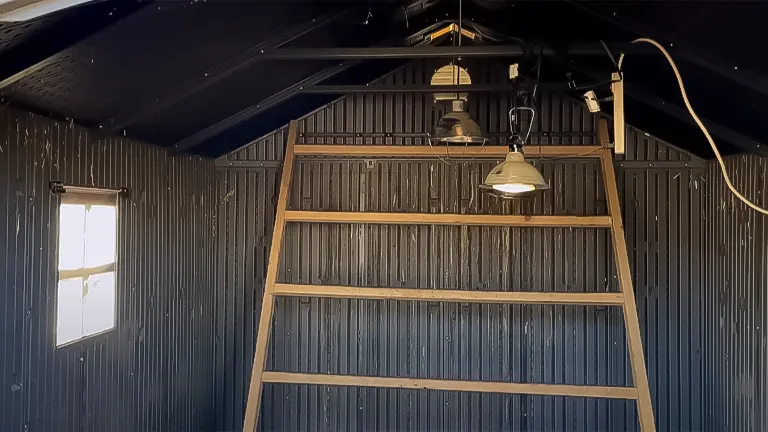
By planning ahead, builders can avoid unnecessary expenses and modifications later on. Sketching detailed plans, considering the coop’s orientation for optimal sunlight and protection from elements, and planning for future expansion can all contribute to a successful and economical chicken coop project.
4. Use Plywood And Other Inexpensive Materials
Plywood and other inexpensive materials are key to constructing a budget-friendly chicken coop. Plywood, known for its durability and versatility, is an excellent choice for walls, floors, and roofs.
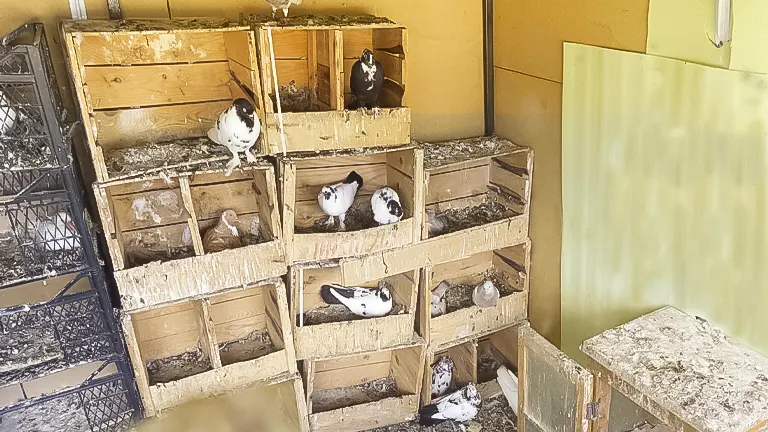
Complementing plywood with affordable materials like corrugated metal for roofing and wire mesh for windows or ventilation can keep costs low while ensuring the coop is secure and weatherproof.
These materials are readily available at most hardware stores and can be easily manipulated to fit various designs, making them ideal for DIY builders looking to create a functional and cost-efficient chicken coop.
5. Reuse A Kitchen Cabinet or Boxy Wooden Structure
Repurposing a kitchen cabinet or a similar boxy wooden structure is an innovative way to create a chicken coop without starting from scratch. This method significantly reduces the amount of construction required, as these structures can serve as the foundation or main body of the coop.
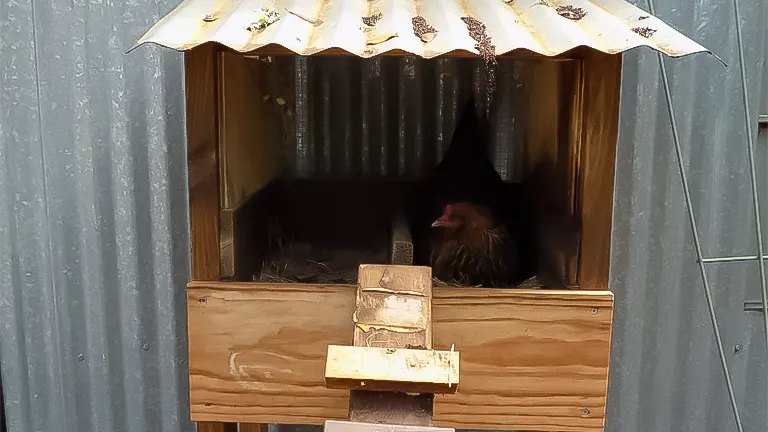
By modifying a pre-existing cabinet or structure with additional openings for doors and ventilation, one can quickly and inexpensively assemble a cozy and secure home for chickens. This approach not only saves money but also gives a second life to bulky items that might otherwise be discarded.
6. Milk Crates Make Great, Easy Nesting Boxes
Milk crates, often available for free or at a low cost, can be transformed into efficient and easy-to-clean nesting boxes for a chicken coop. Their sturdy construction and uniform size make them ideal for this purpose, offering a cozy and secure laying area for chickens.
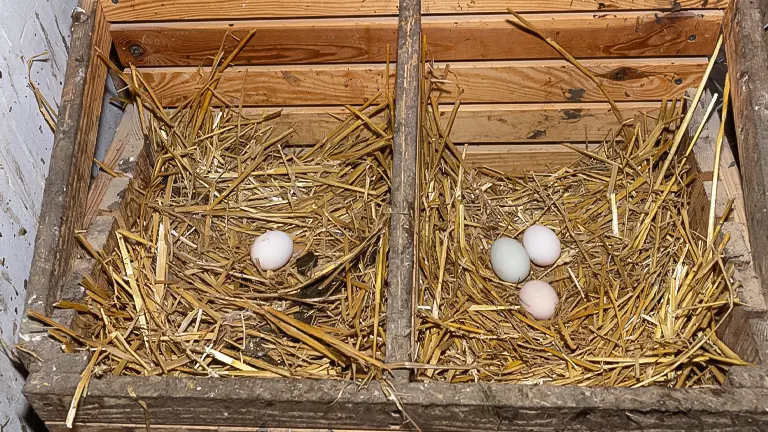
By simply lining them with straw or shavings, milk crates can be integrated into the coop’s design, providing a practical solution for egg-laying without the need for building custom boxes. This repurposing effort is a prime example of how everyday items can be utilized in cost-effective poultry housing.
7. Use Leftover Paint
Applying leftover paint to a DIY chicken coop can significantly enhance its durability and aesthetic appeal without additional cost. Paint provides a protective layer against weather elements, helping to extend the life of the coop’s materials.
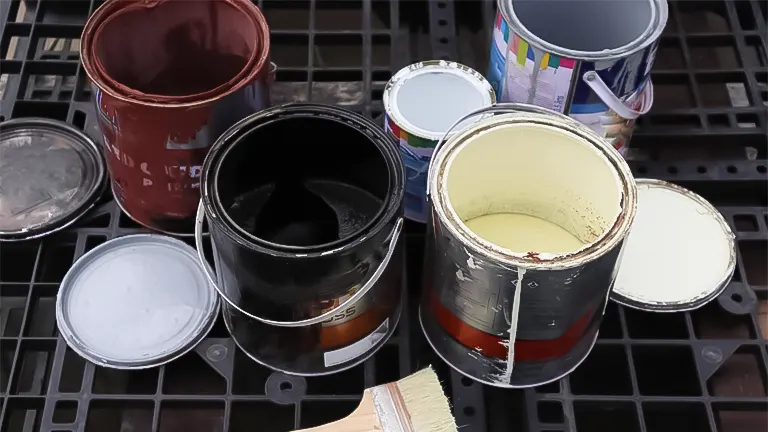
Using leftover paint from previous projects not only saves money but also prevents waste, contributing to a more sustainable building practice. This approach allows for personalization of the coop, making it both a functional and visually pleasing addition to any backyard.
8. Use A Chicken Tractor Instead Of A Traditional Coop
A chicken tractor, a movable chicken coop lacking a floor, is a versatile and cost-effective alternative to a traditional stationary coop. This system allows chickens to access fresh grass and bugs, reducing feed costs and providing natural fertilization to the area.

Building a chicken tractor typically requires fewer materials than a permanent coop, leading to savings on construction costs. The mobility of a chicken tractor offers flexibility in managing the land and the health of the chickens, showcasing an innovative approach to poultry housing that benefits both the birds and the backyard environment.
9. Minimize Expenses Without Sacrificing Quality
It’s crucial to understand that the most economical approach to constructing a chicken coop involves doing it right the first time. This principle applies not only to the coop’s dimensions but also to the quality of the materials and tools you use, as well as the reliability of the construction plan.
Opting for substandard materials or cutting corners during construction might seem like a cost-saving measure initially, but it can lead to increased expenses in the future due to the need for repairs or a complete rebuild. Investing time and effort from the outset to ensure the coop is built properly can prevent repetitive stress and expenses.
Building a chicken coop can represent a significant outlay, especially for beginners in chicken keeping. Yet, this doesn’t necessarily mean it has to be prohibitively expensive. Even those with minimal DIY skills can construct a functional and durable chicken coop with very little expenditure by focusing on quality and thoughtful planning.
Additional Features and Recommendations
The article further describes the creation of a chicken run attached to the coop, emphasizing the importance of security and predator prevention. Utilizing simple materials like two-by-fours and a repurposed chain-link gate, the run provides a safe, enclosed space for the chickens. The author also advocates for deep bedding strategies both inside the coop and in the run, enhancing cleanliness and providing a source of compost.
Critical Analysis
This article is a commendable guide for anyone considering raising chickens but deterred by the high costs of pre-built coops. It stands out for its practicality, detailed instructions, and emphasis on cost-effectiveness. The innovative use of repurposed sheds is a testament to the author’s creativity and resourcefulness.
However, readers might benefit from more detailed safety tips, especially regarding electrical modifications and predator-proofing techniques. Additionally, while the article is rich in practical advice, incorporating more visuals or step-by-step images could enhance understanding and engagement. Overall, this DIY guide is an invaluable resource for aspiring chicken keepers, offering a sustainable and affordable pathway to poultry husbandry
Related Articles:
- Best Bedding For Chickens
- Best Safe Chicken Coop Heater
- 8×8 Chicken Coop Plans
- Turning a Shed Into a Chicken Coop
- How to Make a Chicken Coop Out of Pallets
- Best Sand for Chicken Coop
- How To Insulate a Chicken Coop
- How To Heat a Chicken Coop
- How To Keep Water from Freezing in Chicken Coop
- How to Build a Chicken Coop
- How To Build Chicken Nesting Boxes
- How to Raise Happy and Healthy Chickens in Your Backyard
- When Can Chicks Go Outside? Timing and Tips for a Smooth Transition
- 12 Reasons why Ducks are Better than Chickens
- Best Automatic Chicken Coop Doors 2024: Expert Reviews & Buyer’s Guide
- Best Fans for Chicken Coop 2024: Effective Cooling Solutions Reviewed
Final Thoughts For Building A Cheap And Easy DIY Chicken Coop
Constructing a chicken coop doesn’t have to drain your wallet or require advanced carpentry skills. With strategic planning, sourcing affordable or free materials like wooden pallets, repurposing items such as kitchen cabinets, and utilizing inexpensive materials like plywood, anyone can build a functional and sturdy chicken coop. The key is to focus on quality and durability from the start, ensuring that the coop meets the needs of your chickens without the need for costly repairs or rebuilds in the future. By investing a bit of effort and creativity, even novice DIYers can provide a safe and comfortable home for their chickens, proving that practical and cost-effective solutions are within reach for aspiring chicken keepers.
Frequently Asked Questions
- Can I really build a chicken coop if I have no prior carpentry experience?
Absolutely! Many people have successfully built their own chicken coops with minimal to no carpentry skills by following clear, step-by-step instructions and utilizing simple tools. - Where can I find free or inexpensive materials for my coop?
Look for materials like wooden pallets, discarded wood, or surplus building supplies from local businesses, construction sites, or community recycling centers. Online marketplaces and community boards are also great places to find deals. - How big should my chicken coop be?
The size of your coop will depend on the number of chickens you plan to keep. A general rule is to allocate about 2-3 square feet per chicken inside the coop and about 8-10 square feet per chicken in the outdoor run. - What are the essential features my chicken coop must have?
Your coop should offer ventilation, protection from predators, a place for the chickens to roost at night, nesting boxes for egg laying, and easy access for cleaning. - Is it cheaper to build or buy a chicken coop?
Building your own coop is usually significantly cheaper than buying a pre-made one, especially if you can source free or low-cost materials. - Can I use reclaimed materials for my coop?
Yes, reclaimed materials like wooden pallets, old furniture, or leftover construction materials can be excellent for building a coop, as long as they are safe and free of harmful chemicals. - How do I protect my coop from predators?
Ensure your coop is sturdy with secure latches on doors and windows. Consider burying hardware cloth around the perimeter and covering any openings with wire mesh. - What kind of foundation does my chicken coop need?
A solid foundation isn’t always necessary, but your coop should be placed on level ground. Using concrete blocks or treated wood can help keep it dry and deter predators. - How can I ensure proper ventilation in my coop?
Incorporate windows or vents that can be opened or closed depending on the weather. Make sure the ventilation allows air to flow without creating direct drafts on the chickens. - Are there any legal considerations I need to be aware of before building a chicken coop?
Check your local zoning laws and homeowner association rules, if applicable, for any restrictions on keeping chickens or building structures like a coop in your backyard.
We’re eager to hear from you! If you’ve embarked on creating your own Cheap and Easy DIY Chicken Coop, please share your journey and insights in the comments section below. Your personal experiences and advice could greatly assist fellow enthusiasts in navigating their own coop building projects, helping them to make well-informed choices. Whether it’s triumphs, challenges, or handy tips you’ve discovered along the way, your contributions can enrich our community’s collective knowledge.

Edward Smith
Forestry AuthorWoodworking is about more than crafting; it's a harmonious connection with nature, mastering tools, and preserving our environment. I'm here to share my knowledge and experiences with you, forging a future where we can embrace wood's beauty and utility while safeguarding our forests' health and diversity.













Leave your comment